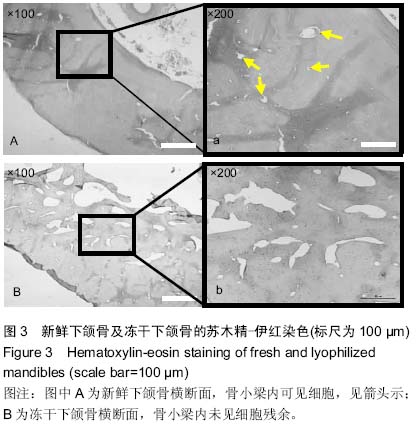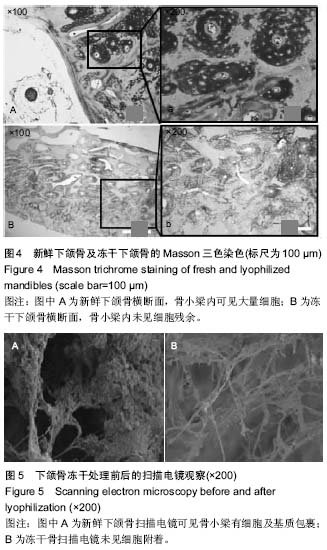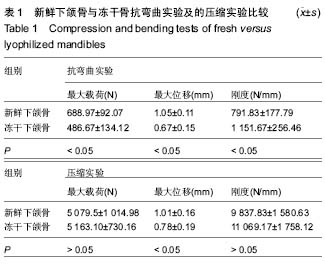中国组织工程研究 ›› 2015, Vol. 19 ›› Issue (25): 3977-3982.doi: 10.3969/j.issn.2095-4344.2015.25.009
• 组织工程骨及软骨材料 tissue-engineered bone and cartilage materials • 上一篇 下一篇
冻干处理犬同种异体下颌骨:满足重建的强度、外形及支持能力
景彩霞,刘昌奎,谭新颖,胡 敏
- 1延安大学医学院病原生物学教研室,陕西省延安市 716000;
2解放军总医院口腔科,北京市 100853
-
出版日期:2015-06-18发布日期:2015-06-18 -
通讯作者:胡敏,教授、博士生导师,解放军总医院口腔科,北京市 100853 -
作者简介:景彩霞,女,1974年生,陕西省延安市人,汉族,2009年四川大学毕业,硕士,讲师,主要从事分子病原生物学研究。 -
基金资助:国家自然科学基金(81470726)
Lyophilizing canine allogeneic mandible: meeting the requirements for rebuilding strength, shape and support capabilities
Jing Cai-xia1, Liu Chang-kui2, Tan Xin-ying2, Hu Min2
- 1Department of Pathogenic Biology, Medical College of Yan’an University, Yan’an 716000, Shaanxi Province, China;
2Department of Stomatology, General Hospital of Chinese PLA, Beijing 100853, China
-
Online:2015-06-18Published:2015-06-18 -
Contact:Hu Min, Professor, Doctoral supervisor, Department of Stomatology, General Hospital of Chinese PLA, Beijing 100853, China -
About author:Jing Cai-xia, Master, Lecturer, Department of Pathogenic Biology, Medical College of Yan’an University, Yan’an 716000, Shaanxi Province, China -
Supported by:the National Natural Science Foundation of China, No. 81470726
摘要:
背景:同种异体颞下颌关节具有良好的外形结构、生物学特性,成为解决髁突缺损的有效方法之一,但是免疫排斥和成骨速度缓慢是同种异体骨移植存在的主要问题。 目的:对犬下颌骨进行冻干处理,使其满足同种异体骨支架重建下颌骨缺损的需要。 方法:获取12只比格犬下颌骨,去除骨膜、软组织、软骨等,用裂钻将颊侧皮质骨制造出直径为1 mm的孔隙,孔隙间距为1.0-2.0 cm。清洗干净后,先放入-4 ℃的冷库中,12 h后逐渐降至-80 ℃保存,1周后将冷冻骨放入干燥机内,使骨组织内剩余水分降低到5%以下,然后进行无菌包装,辐射灭菌后,置于无菌真空器中常温保存。冻干处理后进行生物力学检测。 结果与结论:压缩实验和弯曲实验的载荷-位移曲线均显示冻干骨的最大位移较小,曲线陡直,塑性区不明显,压力一旦超过弹性区迅速出现骨断裂。冻干骨压缩实验的最大载荷为(5 163.10±730.16) N,最大位移为(0.78±0.19) mm,刚度为(11 069.17±1 758.12) N/mm;弯曲实验的最大载荷为(486.67±134.12) N,最大位移为(0.67±0.15) mm,刚度为(1 151.67±256.46) N/mm。表明经水化处理后冷冻干燥犬下颌骨强度可以保持良好的外形及较好的支持能力,能够满足下颌骨修复重建的力学要求。 中国组织工程研究杂志出版内容重点:生物材料;骨生物材料; 口腔生物材料; 纳米材料; 缓释材料; 材料相容性;组织工程
中图分类号:
引用本文
景彩霞,刘昌奎,谭新颖,胡 敏. 冻干处理犬同种异体下颌骨:满足重建的强度、外形及支持能力[J]. 中国组织工程研究, 2015, 19(25): 3977-3982.
Jing Cai-xia, Liu Chang-kui, Tan Xin-ying, Hu Min. Lyophilizing canine allogeneic mandible: meeting the requirements for rebuilding strength, shape and support capabilities [J]. Chinese Journal of Tissue Engineering Research, 2015, 19(25): 3977-3982.

2.1 同种异体冻干骨的组织学观察
苏木精-伊红染色:新鲜骨由致密的骨皮质和内侧的骨松质构成,骨皮质内部为骨松质,是由疏松多孔的组织构成,骨松质内含有大量的细胞;同种异体冻干骨的密致骨和松质骨结构清晰,骨陷窝及松质骨周围没有细胞残余(图3)。

Masson染色:新鲜骨与冻干骨的Masson染色可见骨纤维素被染成红色,胶原纤维呈蓝色,胞浆、肌肉、纤维素、神经胶质呈红色,胞核黑蓝色(图4)。同种异体冻干骨与新鲜骨骨纤维及胶原纤维未见明显区别,说明冻干处理后对骨组织结构没有明显破坏。
2.2 同种异体冻干下颌骨髁突的扫描电镜观察 扫描电镜观察新鲜下颌骨髁突和同种异体冻干下颌骨髁突,可见新鲜骨骨小梁被大量的细胞包绕,而经处理后的同种异体冻干骨其上未见细胞附着(图5)。

2.3 同种异体冻干骨的生物力学测试 新鲜下颌骨抗弯曲实验的最大载荷和最大位移显著高于冻干下颌骨 (P < 0.01),刚度显著低于冻干下颌骨( P < 0.05),见 表1;弯曲实验的断裂部位在加压处,断裂的试样呈裂纹状。
新鲜下颌骨与冻干下颌骨压缩实验的最大载荷、刚度相比差异无显著性意义(P > 0.05),而新鲜下颌骨的最大位移显著高于冻干组(P < 0.05),见表1;压缩实验的断裂部位在舌侧骨皮质相对薄弱处。
| null |
| [1] | 陈子扬, 蒲 锐, 邓 爽, 袁凌燕. 外泌体对运动介导胰岛素抵抗类疾病的调控作用[J]. 中国组织工程研究, 2021, 25(25): 4089-4094. |
| [2] | 陈 扬, 黄邓高, 高元慧, 王顺兰, 曹 卉, 郑琳麟, 何浩伟, 罗思琴, 肖敬川, 张应爱, 张淑芳. 低强度脉冲场超声促进人脂肪间充质干细胞的增殖和黏附[J]. 中国组织工程研究, 2021, 25(25): 3949-3955. |
| [3] | 杨俊辉, 罗金莉, 袁小平. 人生长激素对人牙周膜干细胞增殖及成骨分化的影响[J]. 中国组织工程研究, 2021, 25(25): 3956-3961. |
| [4] | 孙建威, 杨新明, 张 瑛. 孟鲁司特联合骨髓间充质干细胞移植治疗脊髓损伤模型大鼠[J]. 中国组织工程研究, 2021, 25(25): 3962-3969. |
| [5] | 高 珊, 黄东静, 洪海漫, 贾京桥, 孟 斐. 人胎盘间充质干细胞及诱导的胰岛样细胞移植治疗妊娠期糖尿病大鼠效果比较#br#[J]. 中国组织工程研究, 2021, 25(25): 3981-3987. |
| [6] | 郝晓娜, 张英杰, 李玉云, 许 涛. 过表达脯氨酰寡肽酶的骨髓间充质干细胞修复肝纤维化模型大鼠[J]. 中国组织工程研究, 2021, 25(25): 3988-3993. |
| [7] | 刘建友, 贾中伟, 牛佳伟, 曹鑫杰, 张 栋, 魏 杰. 构建股骨3D数字化模型提出一种新的股骨颈前倾角测量方法[J]. 中国组织工程研究, 2021, 25(24): 3779-3783. |
| [8] | 孟令杰, 钱 辉, 盛晓磊, 陆剑锋, 黄建平, 祁连港, 刘宗宝. 3D打印建模联合骨水泥成形微创治疗塌陷Sanders Ⅲ型跟骨骨折[J]. 中国组织工程研究, 2021, 25(24): 3784-3789. |
| [9] | 钱选昆, 黄合飞, 武成聪, 刘克廷, 欧 华, 张金鹏, 任 静, 万建杉. 计算机导航微创经椎间孔腰椎椎间融合治疗腰椎滑脱[J]. 中国组织工程研究, 2021, 25(24): 3790-3795. |
| [10] | 胡 靖, 向 阳, 叶 川, 韩子冀. 3D打印辅助与徒手置钉经皮椎弓根钉内固定治疗胸腰椎骨折的1年随访[J]. 中国组织工程研究, 2021, 25(24): 3804-3809. |
| [11] | 舒启航, 廖亦佳, 薛静波, 晏怡果, 王 程. 新型颈椎3D打印多孔椎间融合器的三维有限元分析[J]. 中国组织工程研究, 2021, 25(24): 3810-3815. |
| [12] | 王一寒, 李 杨, 张 玲, 张 睿, 徐瑞达, 韩晓峰, 程光齐, 王伟力. 数字骨科三维可视化技术在股骨转子间骨折复位内固定中的应用[J]. 中国组织工程研究, 2021, 25(24): 3816-3820. |
| [13] | 孙玛骥, 王秋安, 张星晨, 郭 冲, 袁 峰, 郭开今. 新型颈椎前路经椎弓根固定钉板系统的研制及生物力学分析[J]. 中国组织工程研究, 2021, 25(24): 3821-3825. |
| [14] | 林 旺, 王盈盈, 郭卫中, 袁翠华, 许胜贵, 张申申, 林成寿. 胫骨平台后外侧柱骨折扩大外侧入路内固定增强力学稳定性及膝关节功能[J]. 中国组织工程研究, 2021, 25(24): 3826-3827. |
| [15] | 朱 云, 陈 渝, 邱 皓, 刘 盾, 靳国荣, 陈诗谋, 翁 政. 对侧皮质锁定螺钉治疗骨质疏松股骨骨折的有限元分析[J]. 中国组织工程研究, 2021, 25(24): 3832-3837. |
统计学分析:采用SPSS 13.0软件对新鲜骨组、冻干骨的弯曲实验及压缩实验进行最大载荷、最大位移和刚度
的配对t 检验,P < 0.05表示差异有显著性意义。利用GraphPad prism 6.0 软件对弯曲实验的最大载荷、最大位移及刚度数据绘图。
时间及地点:于2013年1月至2014年8月在解放军总医院口腔研究所完成。
材料:
实验动物:12月龄雌性比格犬16只,购于解放军总医院动物实验中心。
同种异体骨的处理:无菌条件下切取比格犬带髁突的半侧下颌骨,剥离附着的肌肉、血管、结缔组织及髁突表面软骨组织,采用电锯从右侧下颌髁孔处锯断,测量骨段大小,用直径为1 mm骨钻透颊舌侧及髁突表面皮质骨,孔与孔之间间距为3-5 mm(图1A)。用1∶1氯仿/甲醇溶液脱脂处理4 h,生理盐水反复加压冲洗去除残留血液和骨髓;先将移植骨放入-4 ℃的冷库中,12 h后逐渐降至-80 ℃保存,1周后将冷冻骨放入干燥机内,使骨组织内剩余水分降低到5%以下,然后进行无菌包装,辐射灭菌后,置于无菌真空器中常温保存(图1B)。
.jpg)
同种异体冻干骨的检测:
组织学检测:将新鲜的下颌骨和同种异体骨浸入体积分数10%中性甲醛固定24 h,EDTA脱钙至骨组织变软,流水冲洗过夜。脱水机脱水,常规石蜡包埋,3-5 µm切片,苏木精-伊红染色,光镜下观察同种异体骨的组织学结构。
苏木精-伊红染色:①烤片:将骨组织石蜡切片置于 60 ℃恒温箱中烘烤过夜。②脱蜡:将骨组织的石蜡切片依次浸于二甲苯Ⅰ、Ⅱ中各20 min脱蜡,然后浸入无水乙醇中10 min,体积分数95%,85%,75%乙醇中各5 min梯度乙醇水化。③骨组织切片依次放入自来水中2 min,苏木精染色10 min。④自来水冲洗1 min,0.5%盐酸-乙醇快速分化数秒,流水冲洗1 min。⑤切片置于返蓝液中1 min,流水冲洗。⑥伊红染色30 s。⑦体积分数80%,95%,100%乙醇梯度脱水,使用二甲苯Ⅰ、Ⅱ、Ⅲ透明,然后在室温下中性树脂封固,显微镜下观察。
Masson三色染色:①骨组织石蜡切片脱蜡至水(同苏木精-伊红染色)。②自来水、蒸馏水漂洗后用Regaud苏木精染液5-10 min。③自来水冲洗5 min后,蒸馏水洗1遍。④ Masson 丽春红酸性复红液5-10 min。⑤2%冰醋酸水溶液浸洗。⑥1%磷钼酸水溶液分化3-5 min。⑦苯胺蓝液染5 min。⑧0.2%冰醋酸水溶液浸洗。⑨体积分数75%,85%,95%乙醇、无水乙醇、二甲苯透明、中性树胶封固。
扫描电镜观察:将新鲜下颌骨髁突片和同种异体冻干下颌骨髁突片在2.5%戊二醛固定2 h,体积分数30%,50%,70%,90%,100%乙醇梯度脱水(5 min 1次),0.2%磷酸盐缓冲液冲洗3次,每次10 min,醋酸异戊酯置换(15 min 1次),空气干燥。扫描电镜观察处理后的冻干骨与未处理新鲜下颌骨髁突的微观形态及骨小梁情况。
生物力学检测:①抗弯曲生物力学测试:由于下颌骨髁突形态不规则,生物力学检测时不易固定,因此选取部分冻干下颌骨进行生物力学检测。在冻干处理后的下颌骨第二磨牙下方截取高12.0 mm、长8.0 mm的骨段做为抗压缩实验的试件,从下颌骨第一磨牙远中下方向前截取高 5.0 mm、长30.0 mm的骨段做为抗弯曲实验的试件,进行生物力学检测(图2)。冻干骨在测试前6 h放入4 ℃生理盐水中进行水化。然后将其置于实验机的工作台上,以跨距 25 mm、100 N预压3次,消除骨组织黏弹性对测试结果的影响。测试加载速度为0.5 mm/min,测量精度为0.05%。载荷-位移曲线由计算机自动绘制,其在冻干骨出现断裂变形时结束。②抗压缩生物力学测试:方法与抗弯曲生物力学测试相同,仅将预压力调整为200 N。
.jpg)
1 由于下颌骨中颞下颌关节具有特殊的结构和功能,要重建颞下颌关节的精细结构并恢复其功能,目前的组织工程支架在形态和强度上还很难达到这一要求。
3 实验对犬同种异体骨进行冻干处理,并在其表面制造一定孔隙,以提高其成骨速度,尽管强度有所下降,但仍能达到重建下颌骨及颞下颌关节的要求,组织病理检查及扫描电镜观察证实冻干处理后的同种异体骨活细胞全部被消除,有效降低了其免疫原性。
| 阅读次数 | ||||||
|
全文 |
|
|||||
|
摘要 |
|
|||||